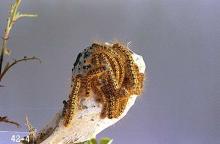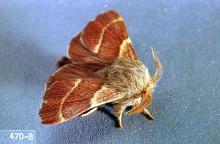Malacosoma californicum
Pest description and crop damage The western tent caterpillar attacks a wide variety of plants besides hawthorn, including alder, ash, birch, cottonwood, and willow, as well as fruit trees and roses. The adult moths are stout, light to darker brown, and are active in early to midsummer. They are attracted to lights at night. Larvae of the western tent caterpillar are hairy, dull yellow-brown, with rows of blue and orange spots on the body. Eggs of these moths are laid on twigs or buildings in masses. These are brown to gray in color, about 0.0625 inch long, and look like Styrofoam®. The larvae feed in large groups on foliage of host plants and can do significant damage by defoliation. Larvae of western tent caterpillars build large silken tents over leaves on which they feed. Larvae can totally defoliate small trees, which may not kill them but reduces growth and makes the trees more susceptible to diseases or poor weather. Healthy trees usually will grow new leaves by midsummer.
Scouting and thresholds Look for egg masses on twigs or other overwintering sites. Masses of young larvae are identified easily in early spring.
Management-biological control
See:
Biological Control of Nursery Pests
Tent caterpillars have many natural enemies. Some birds eat the caterpillars, and small mammals consume the pupae. The larvae of a tachinid fly parasitizes the caterpillars.
Management- cultural control
Overwintering egg masses can be removed and destroyed when practical.
Management-chemical control
Dormant-season spray oil spray
Apply with enough water to cover the entire tree thoroughly. Apply in delayed-dormant period to destroy overwintering egg masses.
Growing-season spray
Spray in spring after overwintering eggs hatch, at about the time leaves are 0.75 to 1 inch long. Control is much more effective if sprays are applied when larvae are small.
See:
Chemical Control of Nursery Pests
For more information
PNW Nursery IPM: Western tent caterpillar (https://agsci.oregonstate.edu/nurspest/insects/western-tent-caterpillar)





